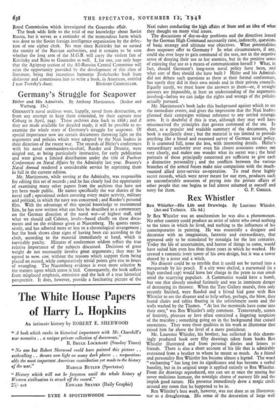Rex Whistler
IF Rex Whistler was an anachronism he was also a phenomenon. No other country could produce an artist of talent who owed nothing to the times in which he lived, and nothing to the influences of his contemporaries in painting. He was essentially a designer and decorator with an imagination, fantastic and extraordinary, that appeared only to be stimulated by nostalgia for the last centuries. Today the life of uncertainties, and horror of things to come, would have suited him even less than those years in which he worked. He created a romantic ivory tower of his own design, but it was a tower shared by a jester and a witch.
No disaster could be so terrible that it could not be turned' into a masquerade by his pencil. If a city were shelled, a nursemaid (in a high starched cap) would leave her charge in the pram to run amok amid the scurrying populace. A Communist would have a bomb, but one that already smoked furiously and was in imminent danger of destroying its thrower. When the Tate Gallery murals, then only recently finished, were flooded and a friend had gone with Rex Whistler to see the disaster and to help soften, perhaps, the blow, they found chairs and tables floating in the refreshment room and the walls washed by the Thames. " At last the mermaids have come into their own," was Rex Whistler's only comment. Transversely, scenes of festivity, pleasure or love often contained a lingering suspicion of the macabre ; something going on in the background that caused uneasiness. They were these qualities in his work as illustrator that raised him far above the level of a mere pasticheur.
Mr. Laurence Whistler, his brother, has collected in this charm- ingly produced book over fifty drawings taken from books Rex Whistler illustrated and from personal diaries and letters to friends. There is also a short account of his life that is admirably restrained from a brother to whom he meant so much. As a friend and personality Rex Whistler has become almost a legend. The word " enchanting " has long lost its significance and has become a verbal banality, but in its original usage it applied entirely to Rex Whistler. From the drawings reproduced, one can see at once the teasing but never malicious humour, the nostalgic charm of nursery life and the impish good nature. His presence immediately drew a magic circle around any room that he happened to be in.
Rex Whistler's best work, however, was not done as an illustrator, nor as a draughtsman. His sense :>f the decoration of large wall
° - spaces, whether in a country house or on the stage, was unrivalled in England during his working years. Mr. Laurence Whistler refers to these mural decorations, and mentions that many are in private hands. What a pity that these were not reproduced in the present book for all to see! It is not enough to be told of Neptune's foot- prints, painted as padding out of the Plas Newydd dining-room wall and wandering round the house ; and we should also like to see the mouse painted on the floor-board at Mottisfont, which the owner used to swear had been worried by a cat, so lifelike does it seem. Many of the brilliant period settings and costumes for the theatre have been published already, some in colour, but here the lack of colour is conspicuous, and it is sad that the first book on the life and work of Rex Whistler should show neither his delicious colour sense nor his best decorative work. Perhaps Mr. Laurence Whistler can be persuaded to produce a further and more comprehensive book on his brother's work ; a book that will even more surely convince those who had not the privilege of knowing Rex Whistler personally that his death was a tragic loss. He was able to focus and bring closer all the memories of childhood in an age when artists of the never-never land are rarer than the ogres they depict. One must be extremely grateful to Mr. Laurence Whistler for reminding us of
this fact by his delightful tribute. DEREK HILL.



































 Previous page
Previous page